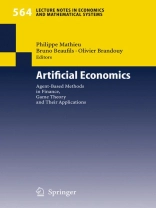Agent-based Computational Economics (ACE) is a new discipline of economics, largely grounded on concepts like evolution, auto-organisation and emergence: it intensively uses computer simulations as well as artificial intelligence, mostly based on multi-agents systems. The purpose of this book is to give an up-to date view of the scientific production in the fields of Agent-based Computational Economics (mainly in Market Finance and Game Theory). Based on communications given at AE’2005 (Lille, USTL, France), this book offers a wide panorama of recent advances in ACE (both theoretical and methodological) that will interest academics as well as practitioners.
Table des matières
Artificial Stock Markets.- Time Series Properties from an Artificial Stock Market with a Walrasian Auctioneer.- Market Dynamics and Agents Behaviors: a Computational Approach.- Traders Imprint Themselves by Adaptively Updating their Own Avatar.- Learning in Models.- Learning in Continuous Double Auction Market.- Firms Adaptation in Dynamic Economic Systems.- Firm Size Dynamics in a Cournot Computational Model.- Case-Studies and Applications.- Emergence of a Self-Organized Dynamic Fishery Sector: Application to Simulation of the Small-Scale Fresh Fish Supply Chain in Senegal..- Multi-Agent Model of Trust in a Human Game.- A Counterexample for the Bullwhip Effect in a Supply Chain.- Bottom-Up Approaches.- Collective Efficiency in Two-Sided Matching.- Complex Dynamics, Financial Fragility and Stylized Facts.- Noisy Trading in the Large Market Limit.- Emergence in Multi-Agent Systems: Cognitive Hierarchy, Detection, and Complexity Reduction part I: Methodological Issues.- Methodological Issues.- The Implications of Case-Based Reasoning in Strategic Contexts.- A Model of Myerson-Nash Equilibria in Networks.- Market Dynamics.- Stock Price Dynamics in Artificial Multi-Agent Stock Markets.- Market Failure Caused by Quality Uncertainty.- Learning and the Price Dynamics of a Double-Auction Financial Market with Portfolio Traders.- How Do the Differences Among Order Distributions Affect the Rate of Investment Returns and the Contract Rate.












